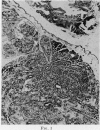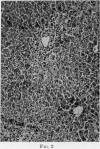Abstract
Single toxic doses of 1,2-dimethylhydrazine induced mild centrilobular necrosis of the liver in rats and mice. Ultrastructural studies showed hepatic nuclear changes including nucleolar microsegregation and changes in the endoplasmic reticulum and mitochondria. 1-Methylhydrazine caused little morphological change in the liver. Tumours of the colon and kidney and also massive cystic hyperplasia of the liver were found in some of the rats and tumours of the anal margin and kidney in some of the mice, following single doses of 1,2-dimethylhydrazine. Incorporation of amino acids into rat liver proteins was inhibited by 1,2-dimethylhydrazine, which also caused disaggregation of hepatic polysomes. No effects on hepatic protein synthesis by 1,1-dimethylhydrazine or 1-methylhydrazine were observed. Similarities between the effects of 1,2-dimethylhydrazine, cycasin and dimethylnitrosamine are discussed.
Full text
PDF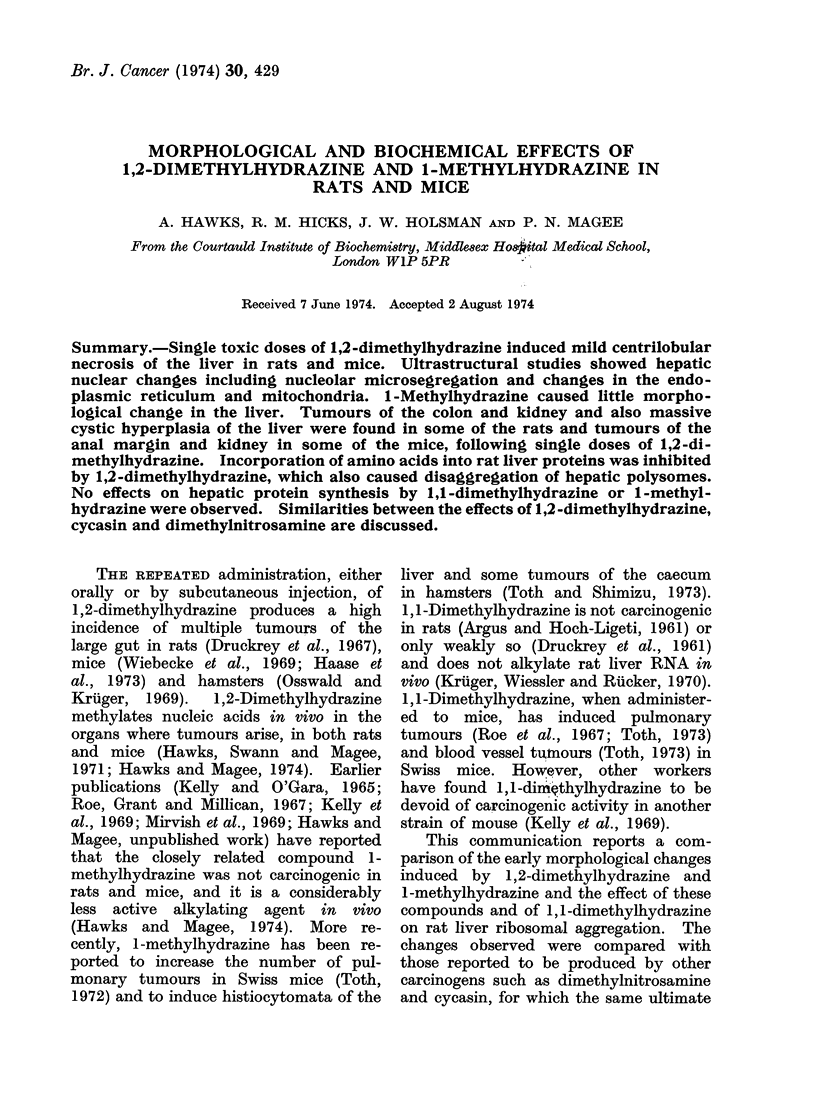
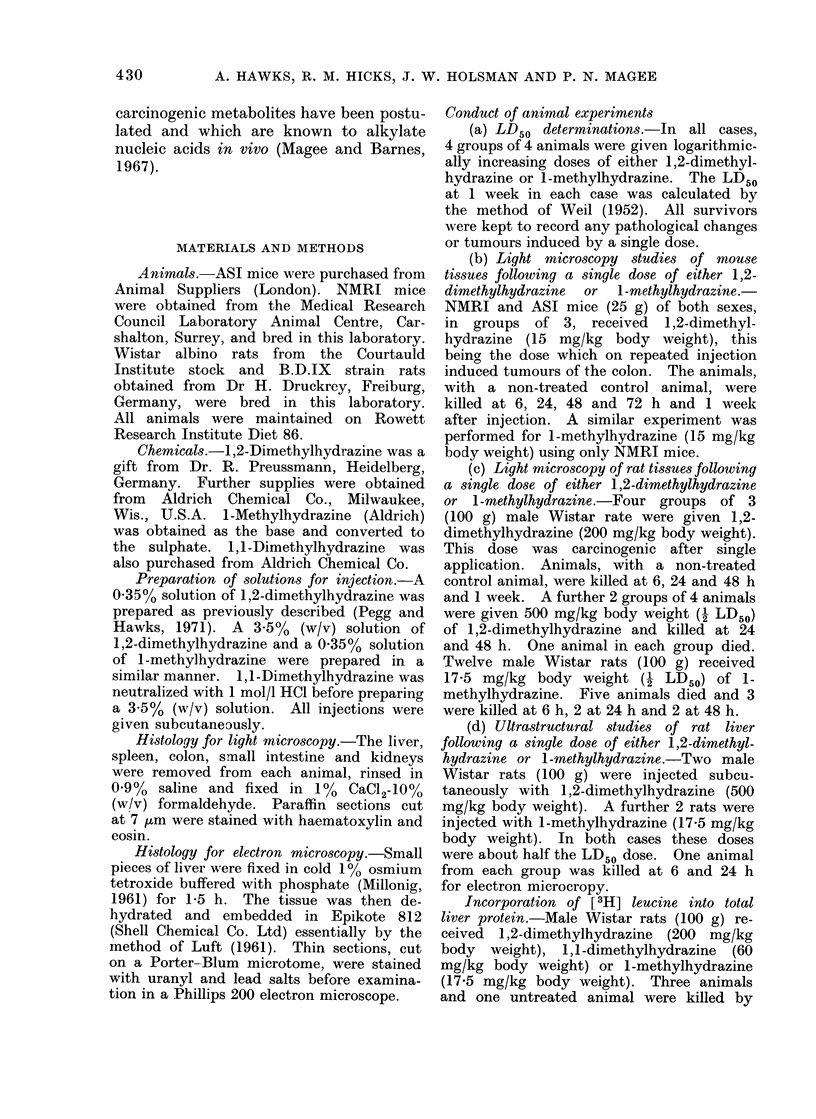
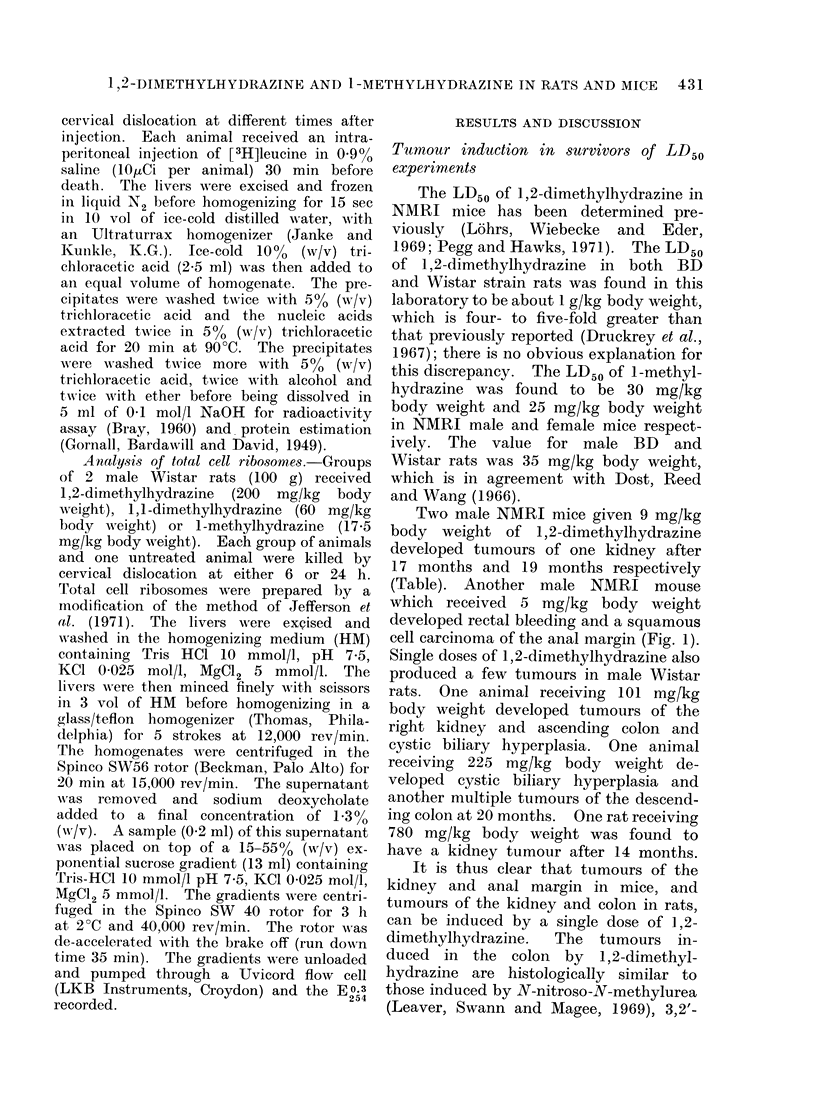
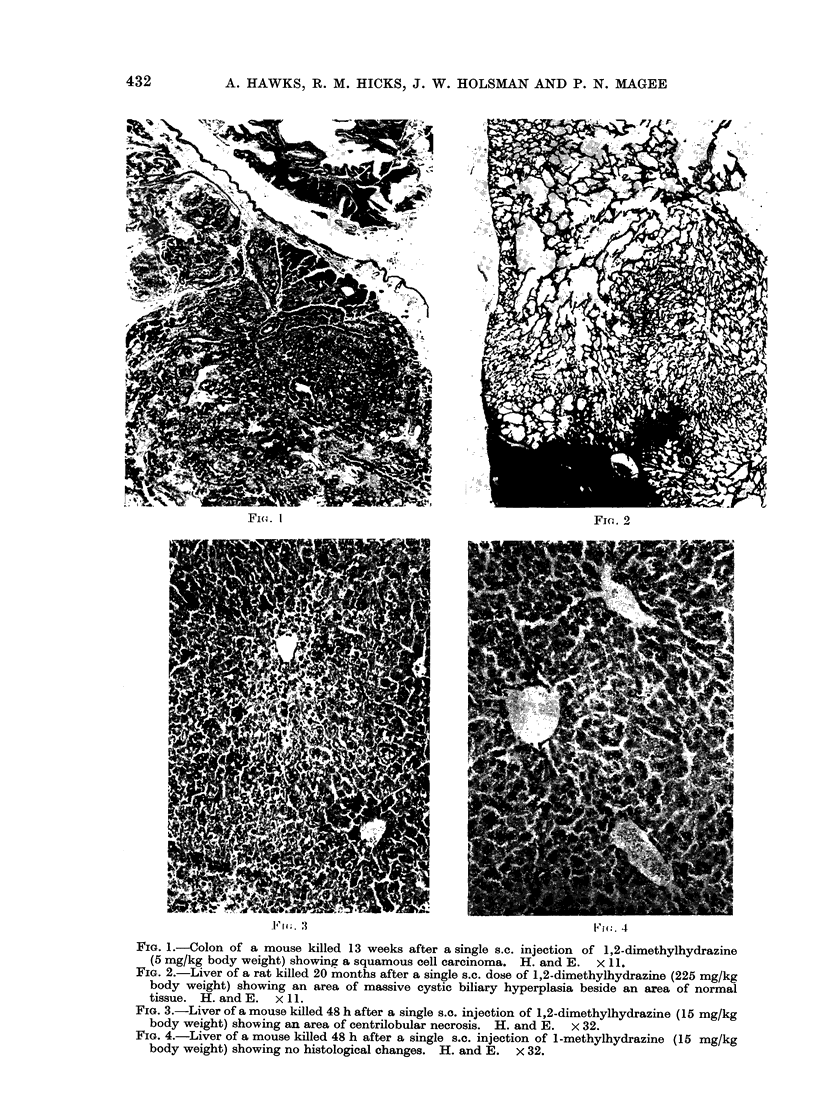
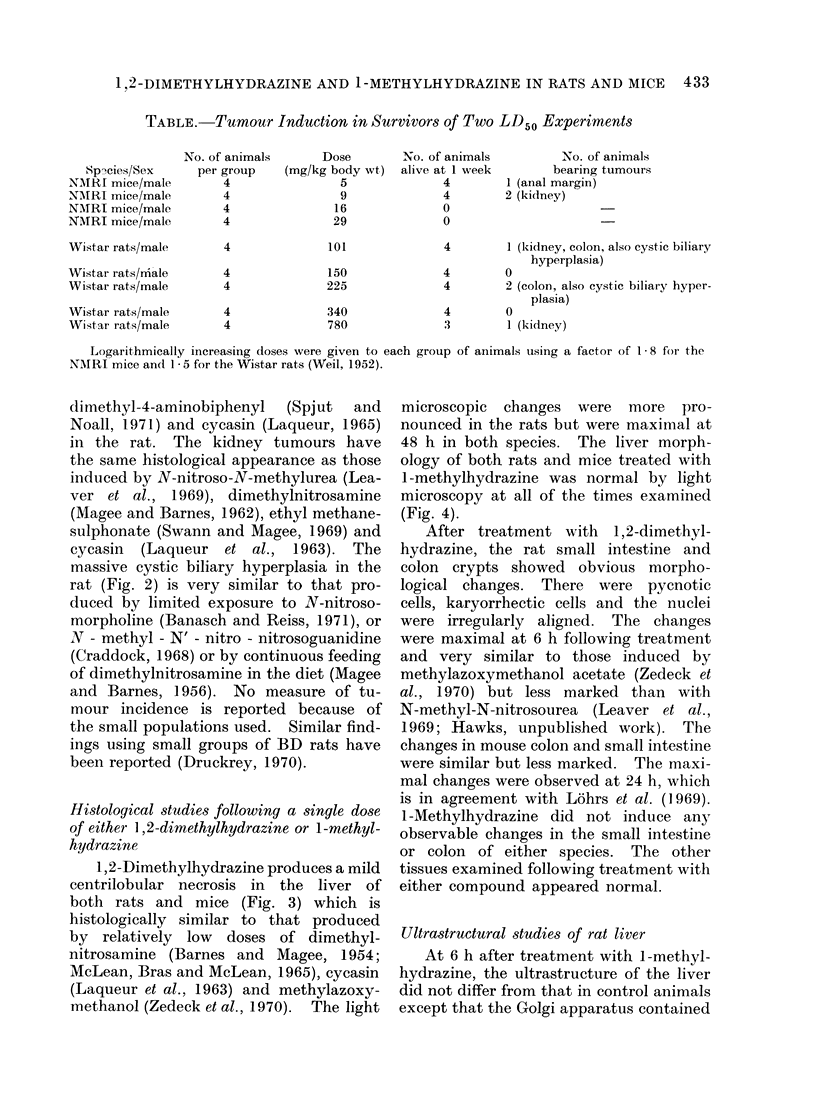
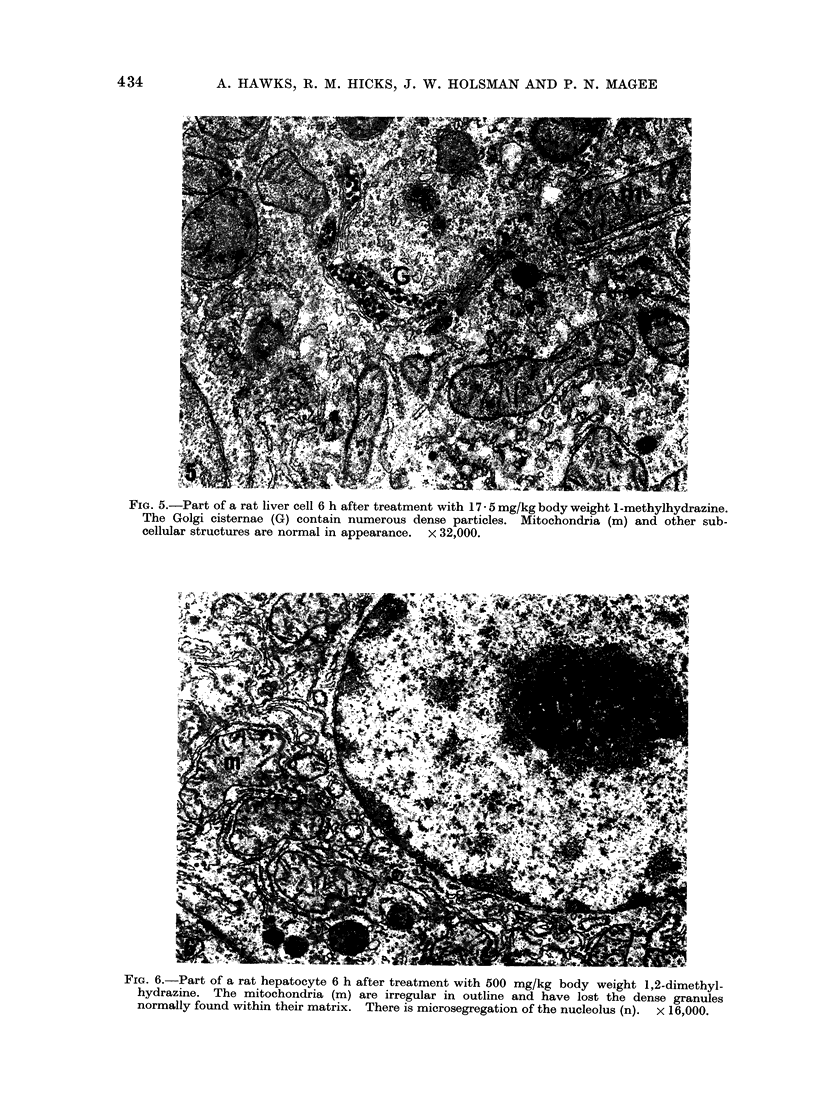
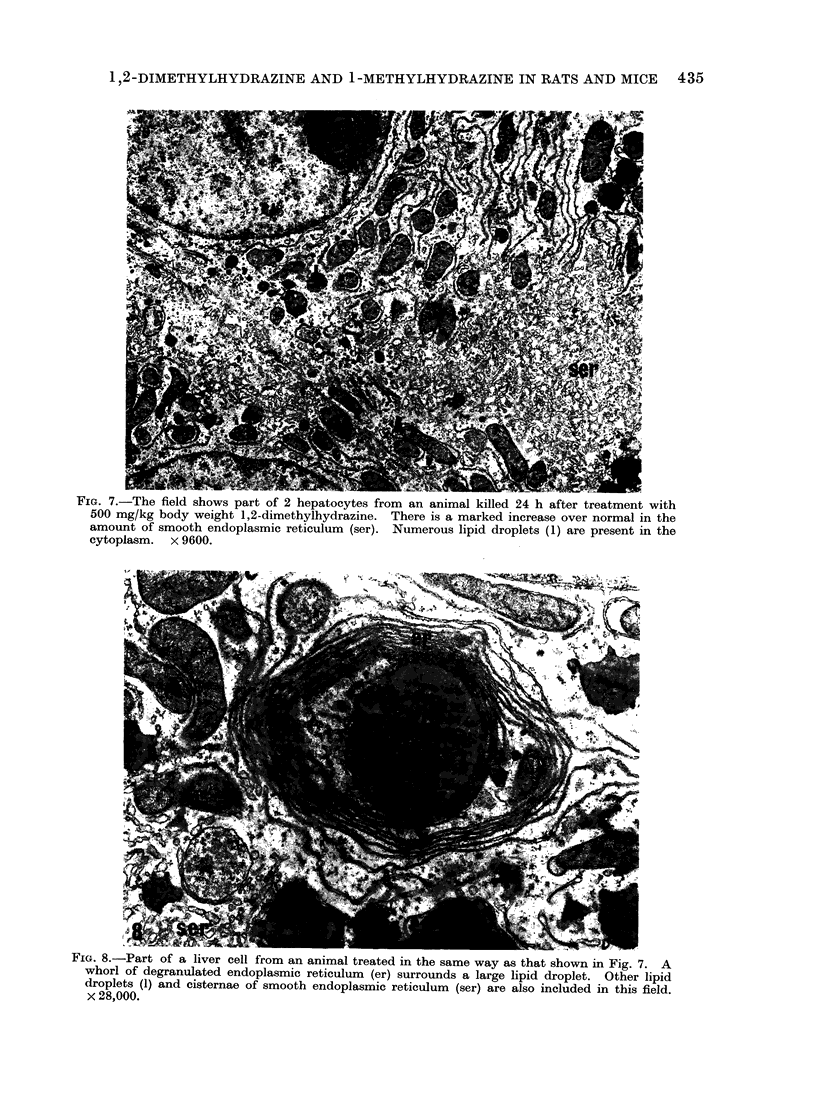
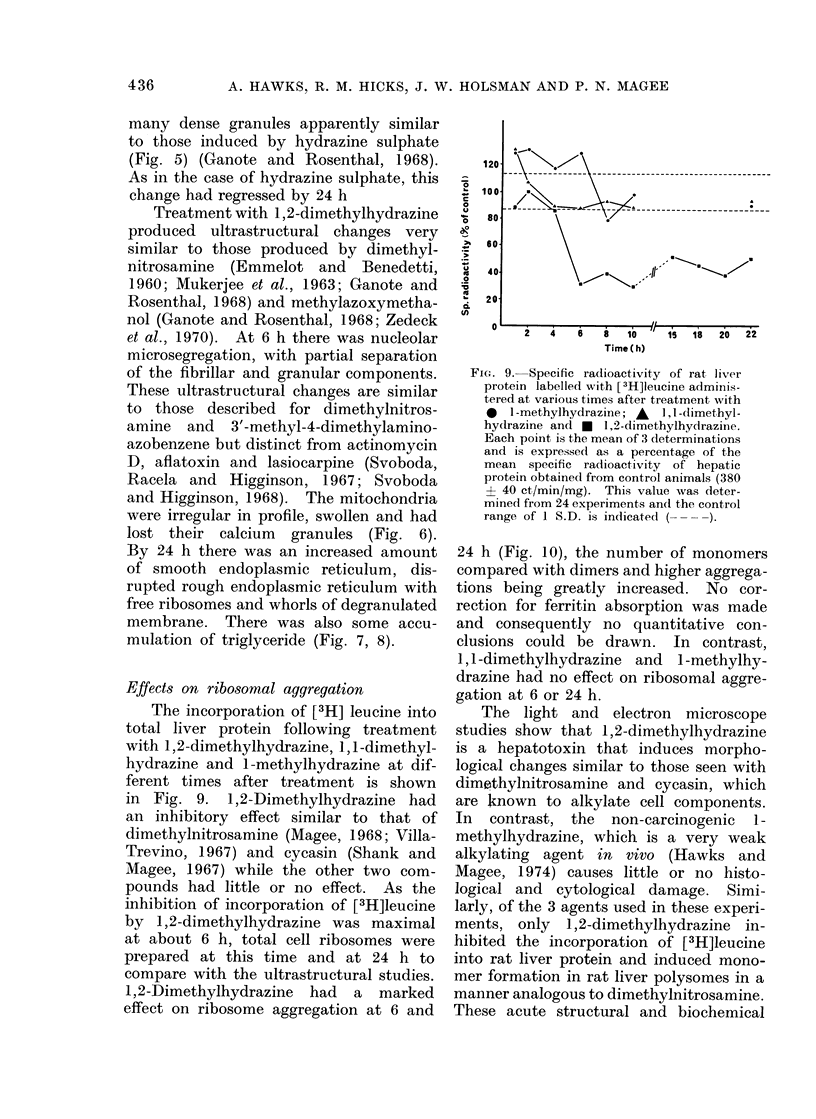
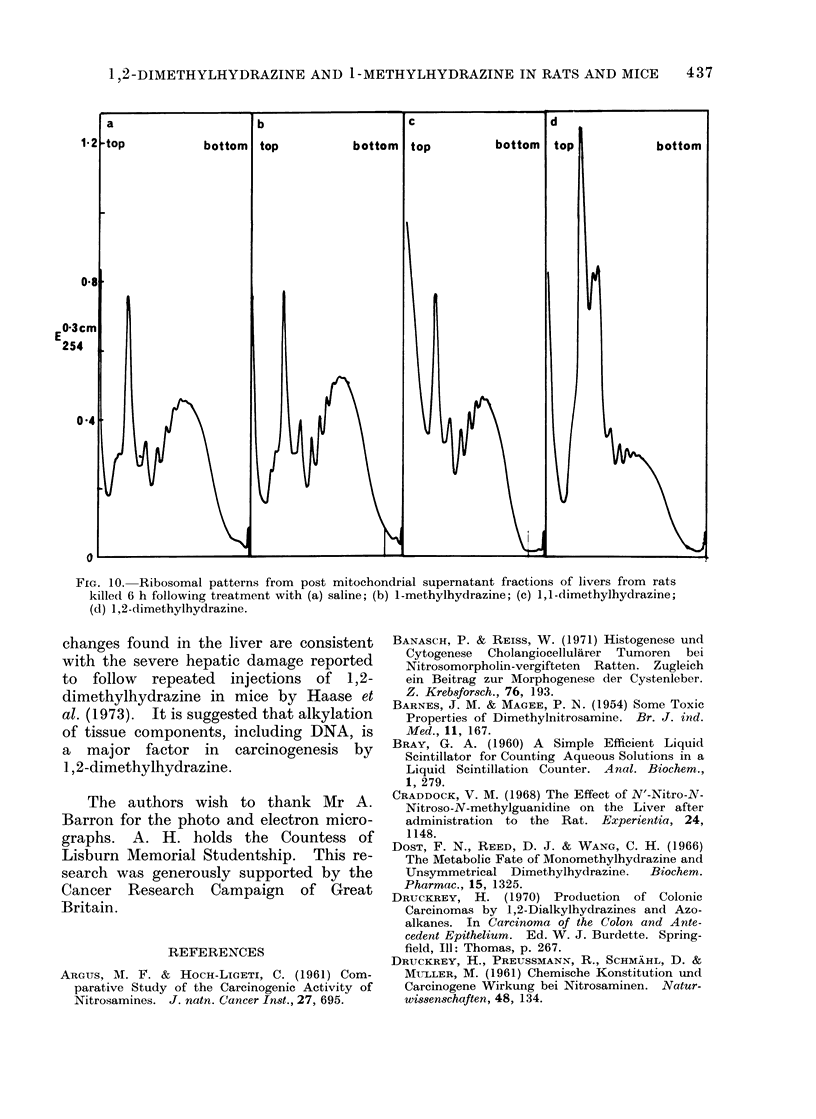

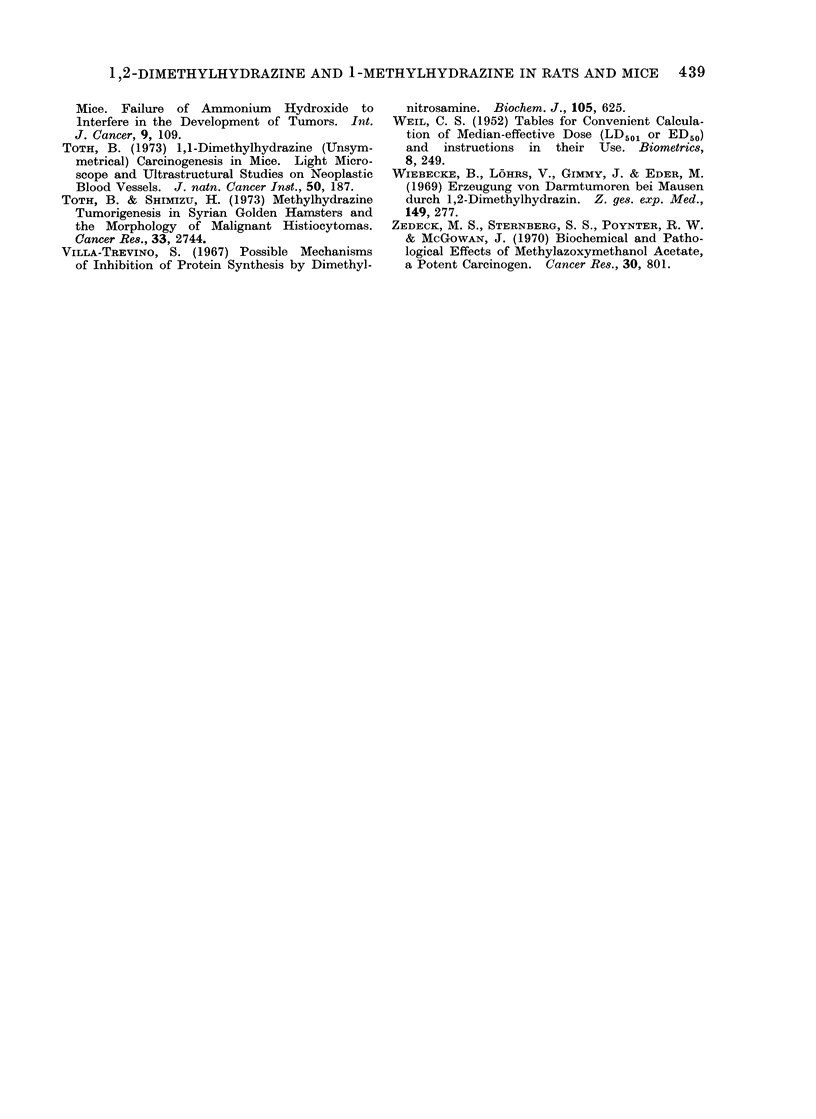
Images in this article
Selected References
These references are in PubMed. This may not be the complete list of references from this article.
- ARGUS M. F., HOCH-LIGETI C. Comparative study of the carcinogenic activity of nitrosamines. J Natl Cancer Inst. 1961 Sep;27:695–709. [PubMed] [Google Scholar]
- BARNES J. M., MAGEE P. N. Some toxic properties of dimethylnitrosamine. Br J Ind Med. 1954 Jul;11(3):167–174. doi: 10.1136/oem.11.3.167. [DOI] [PMC free article] [PubMed] [Google Scholar]
- Bannasch P., Reiss W. Histogenese und Cytogenese cholangiocellulärer Tumoren bei Nitrosomorpholin-vergifteten Ratten. Zubleich ein Beitrag zur Morphogenese der Cystenleber. Z Krebsforsch Klin Onkol Cancer Res Clin Oncol. 1971;76(3):193–215. doi: 10.1007/BF00303564. [DOI] [PubMed] [Google Scholar]
- Craddock V. M. The effect of N'-nitro-N-nitrose-N-methylguanidine on the liver after administration to the rat. Experientia. 1968 Nov 15;24(11):1148–1149. doi: 10.1007/BF02147818. [DOI] [PubMed] [Google Scholar]
- Druckrey H., Preussmann R., Matzkies F., Ivankovic S. Selektive Erzeugung von Darmkrebs bei Ratten durch 1,2-Dimethyl-hydrazin. Naturwissenschaften. 1967 Jun;54(11):285–286. doi: 10.1007/BF00620890. [DOI] [PubMed] [Google Scholar]
- EMMELOT P., BENEDETTI E. L. Changes in the fine structure of rat liver cells brought about by dimethylnitrosamine. J Biophys Biochem Cytol. 1960 Apr;7:393–396. doi: 10.1083/jcb.7.2.393. [DOI] [PMC free article] [PubMed] [Google Scholar]
- Ganote C. E., Rosenthal A. S. Characteristic lesions of methylazoxymethanol-induced liver damage. A comparative ultrastructural study with dimethylnitrosamine, hydrazine sulfate, and carbon tetrachloride. Lab Invest. 1968 Oct;19(4):382–398. [PubMed] [Google Scholar]
- Haase P., Cowen D. M., Knowles J. C., Cooper E. H. Evaluation of dimethylhydrazine induced tumours in mice as a model system for colorectal cancer. Br J Cancer. 1973 Dec;28(6):530–543. doi: 10.1038/bjc.1973.183. [DOI] [PMC free article] [PubMed] [Google Scholar]
- Hawks A., Magee P. N. The alkylation of nucleic acids of rat and mouse in vivo by the carcinogen 1,2-dimethylhydrazine. Br J Cancer. 1974 Nov;30(5):440–447. doi: 10.1038/bjc.1974.218. [DOI] [PMC free article] [PubMed] [Google Scholar]
- Hawks A., Swann P. F., Magee P. N. Probable methylation of nucleic acids of mouse colon by 1,2-dimethylhydrazine in vivo. Biochem Pharmacol. 1972 Feb 1;21(3):432–433. doi: 10.1016/0006-2952(72)90359-0. [DOI] [PubMed] [Google Scholar]
- Jefferson L. S., Wolpert E. B., Giger K. E., Morgan H. E. Regulation of protein synthesis in heart muscle. 3. Effect of anoxia on protein synthesis. J Biol Chem. 1971 Apr 10;246(7):2171–2178. [PubMed] [Google Scholar]
- Kelly M. G., O'Gara R. W., Yancey S. T., Gadekar K., Botkin C., Oliverio V. T. Comparative carcinogenicity of N-isopropyl-alpha-(2-methylhydraziono)-p-toluamide. HCI (procarbazine hydrochloride), its degradation products, other hydrazines, and isonicotinic acid hydrazide. J Natl Cancer Inst. 1969 Feb;42(2):337–344. [PubMed] [Google Scholar]
- Krüger F. W., Wiessler M., Rücker U. Investigation of the alkylating action of 1,1-dimethylhydrazine. Biochem Pharmacol. 1970 May;19(5):1825–1825. doi: 10.1016/0006-2952(70)90176-0. [DOI] [PubMed] [Google Scholar]
- LAQUEUR G. L., MICKELSEN O., WHITING M. G., KURLAND L. T. CARCINOGENIC PROPERTIES OF NUTS FROM CYCAS CIRCINALIS L. INDIGENOUS TO GUAM. J Natl Cancer Inst. 1963 Oct;31:919–951. [PubMed] [Google Scholar]
- LUFT J. H. Improvements in epoxy resin embedding methods. J Biophys Biochem Cytol. 1961 Feb;9:409–414. doi: 10.1083/jcb.9.2.409. [DOI] [PMC free article] [PubMed] [Google Scholar]
- Löhrs U., Wiebecke B., Eder M. Morphologische und autoradiographische Untersuchung der Darmschleimhautveränderungen nach einmaliger Injektion von 1,2-Dimethylhydrazin. Z Gesamte Exp Med. 1969 Dec 31;151(4):297–307. [PubMed] [Google Scholar]
- MAGEE P. N., BARNES J. M. Induction of kidney tumours in the rat with dimethylnitrosamine (N-nitrosodimethylamine). J Pathol Bacteriol. 1962 Jul;84:19–31. doi: 10.1002/path.1700840103. [DOI] [PubMed] [Google Scholar]
- MAGEE P. N., BARNES J. M. The production of malignant primary hepatic tumours in the rat by feeding dimethylnitrosamine. Br J Cancer. 1956 Mar;10(1):114–122. doi: 10.1038/bjc.1956.15. [DOI] [PMC free article] [PubMed] [Google Scholar]
- MAGEE P. N. Toxic liver injury; inhibition of protein synthesis in rat liver by dimethylnitrosamine in vivo. Biochem J. 1958 Dec;70(4):606–611. doi: 10.1042/bj0700606. [DOI] [PMC free article] [PubMed] [Google Scholar]
- MUKHERJEE T., GUSTAFSSON R. G., AFZELIUS B. A., ARRHENIUS E. EFFECTS OF CARCINOGENIC AMINES ON AMINO ACID INCORPORATION BY LIVER SYSTEMS. II. A MORPHOLOGICAL AND BIOCHEMICAL STUDY ON THE EFFECT OF DIMETHYLNITROSAMINE. Cancer Res. 1963 Jul;23:944–953. [PubMed] [Google Scholar]
- Magee P. N., Barnes J. M. Carcinogenic nitroso compounds. Adv Cancer Res. 1967;10:163–246. doi: 10.1016/s0065-230x(08)60079-2. [DOI] [PubMed] [Google Scholar]
- McLean E., Bras G., McLean A. E. Venous occlusions in the liver following dimethylnitrosamine. Br J Exp Pathol. 1965 Aug;46(4):367–369. [PMC free article] [PubMed] [Google Scholar]
- Mirvish S. S., Chen L., Haran-Ghera N., Berenblum I. Comparative study of lung carcinogenesis, promoting action in leukaemogenesis and initiating action in skin tumorigenesis by urethane, hydrazine and related compounds. Int J Cancer. 1969 May 15;4(3):318–326. doi: 10.1002/ijc.2910040309. [DOI] [PubMed] [Google Scholar]
- Osswald H., Krüger F. W. Die cancerogene Wirkung von 1,2-Dimethylhydrazin beim Goldhamster. Arzneimittelforschung. 1969 Nov;19(11):1891–1892. [PubMed] [Google Scholar]
- Pegg A. E., Hawks A. Increased transfer ribonucleic acid methylase activity in tumours induced in the mouse colon by the administration of 1,2-dimethylhydrazine. Biochem J. 1971 Mar;122(1):121–123. doi: 10.1042/bj1220121. [DOI] [PMC free article] [PubMed] [Google Scholar]
- Roe F. J., Grant G. A., Millican D. M. Carcinogenicity of hydrazine and 1,1-dimethylhydrazine for mouse lung. Nature. 1967 Oct 28;216(5113):375–376. doi: 10.1038/216375a0. [DOI] [PubMed] [Google Scholar]
- Shank R. C., Magee P. N. Similarities between the biochemical actions of cycasin and dimethylnitrosamine. Biochem J. 1967 Nov;105(2):521–527. doi: 10.1042/bj1050521. [DOI] [PMC free article] [PubMed] [Google Scholar]
- Spjut H. J., Noall M. W. Experimental induction of tumors of the large bowel of rats. A review of the experience with 3-2' dimethyl-4-aminobiphenyl. Cancer. 1971 Jul;28(1):29–37. doi: 10.1002/1097-0142(197107)28:1<29::aid-cncr2820280107>3.0.co;2-x. [DOI] [PubMed] [Google Scholar]
- Svoboda D., Higginson J. A comparison of ultrastructural changes in rat liver due to chemical carcinogens. Cancer Res. 1968 Sep;28(9):1703–1733. [PubMed] [Google Scholar]
- Swann P. F., Magee P. N. Induction of rat kidney tumours by ethyl methanesulphonate and nervous tissue tumours by methyl methanesulphonate and ethyl methanesulphonate. Nature. 1969 Aug 30;223(5209):947–949. doi: 10.1038/223947a0. [DOI] [PubMed] [Google Scholar]
- Toth B. Hydrazine, methylhydrazine and methylhydrazine sulfate carcinogenesis in Swiss mice. Failure of ammonium hydroxide to interfere in the development of tumors. Int J Cancer. 1972 Jan 15;9(1):109–118. doi: 10.1002/ijc.2910090113. [DOI] [PubMed] [Google Scholar]
- Toth B., Shimizu H. Methylhydrazine tumorigenesis in Syrian golden hamsters and the morphology of malignant histiocytomas. Cancer Res. 1973 Nov;33(11):2744–2753. [PubMed] [Google Scholar]
- Villa-Treviño S. A possible mechanism of inhibition of protein synthesis by dimethylnitrosamine. Biochem J. 1967 Nov;105(2):625–631. doi: 10.1042/bj1050625. [DOI] [PMC free article] [PubMed] [Google Scholar]
- Wiebecke B., Löhrs U., Gimmy J., Eder M. Erzeugung von Darmtumoren bei Mäusen durch 1,2-Dimethylhydrazin. Z Gesamte Exp Med. 1969;149(3):277–278. [PubMed] [Google Scholar]
- Zedeck M. S., Sternberg S. S., Poynter R. W., McGowan J. Biochemical and pathological effects of methylazoxymethanol acetate, a potent carcinogen. Cancer Res. 1970 Mar;30(3):801–812. [PubMed] [Google Scholar]



